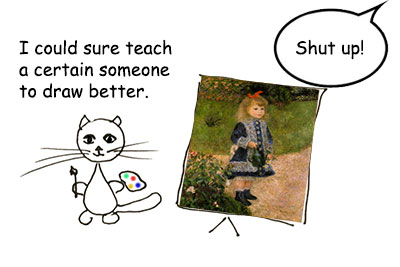
In a previous post, I suggested three questions writers should consider when adding outside source material to their writing:
In today’s post, I’ll look at three potentially problematic issues related to quoting and paraphrasing and give tips to be successful with each.
Signal Phrases
When you want to use a quotation in your work, you must signal in your own words that a quote is coming. I often see writers end a sentence and then start a quoted sentence immediately after. Here’s an example:
Cats and dogs are very interesting to observe. “House pets can teach us many things even about human behavior” (Smith, 2015, p. 101).
This is quote plopping, and you should not do it! Use a signal phrase to show someone else’s words are coming. Here is the same example, this time with a specific signal phrase:
Cats and dogs are very interesting to observe. In her study comparing animal and human eating habits, Smith (2015) examined how “House pets can teach us many things even about healthy living” (p. 101).
 When your subject matter is complicated and the link between your paper’s arguments and the included quote is not necessarily obvious, signal phrases are especially important. In such cases, your signal phrase is your way to help your readers make important connections between your ideas and those in your source material.
When your subject matter is complicated and the link between your paper’s arguments and the included quote is not necessarily obvious, signal phrases are especially important. In such cases, your signal phrase is your way to help your readers make important connections between your ideas and those in your source material.
One important note about verb tense in signal phrases: APA uses past or present perfect tense, and Chicago and MLA use present. The example above about animal behavior uses APA style. In MLA or Chicago, the signal phrase would use present tense: “Smith explains.”
Get a free sample proofread and edit for your words.
Two professional proofreaders will proofread and edit your words.
Block Quote Format
A block quote is used when quoting a longer passage; the definition of longer depends on the style guide you are using. If you are using MLA, a block quote is used for four or more entire lines of prose and three or more entire lines of poetry in verse. For the Chicago Manual of Style, it’s five or more lines of prose or two or more lines of verse. For APA, a block quote is used for a quotation of more than 40 words.
The format of a block quote is similar for different style guides. Start the quotation on a new line after your signal phrase. Indent the entire quote ½ inch at the left. Do not use quotation marks; the indentation itself shows the material is a quote. Citation, whether parenthetical or in footnote form, comes after the final period of the quotation. Note that double spacing continues through block quotes in MLA and APA, but in Chicago block quotes should be single spaced.
Punctuating Short Quotations
Unlike block quotes, short quotations do need to be enclosed in quotation marks, and they appear in line with the rest of the paragraph. With short quotes, a few differences between US and Canadian English and UK English can cause some confusion.
One such point of confusion is whether to use single or double quotation marks. US and Canadian English use double quotation marks to enclose quoted material and single quotation marks to enclose internal quotes. UK English does just the opposite: single quotation marks for the main quote, doubles for internal quotes.
US English: Johnson (2008) showed study participants “cartoons of dogs saying ‘Meow!’ to cats” (p. 101).
UK English: Johnson (2008) showed study participants ‘cartoons of dogs saying “Meow!” to cats’ (p. 101).
Another US and Canadian vs. UK English difference has to do with the proper order of ending quotation marks, periods and commas, and footnotes. Here’s an example:
US English: Jones argues that “two heads are better than one.”1
UK English: Jones argues that ‘two heads are better than one’. 1
Here’s an example showing what happens when the quote is at the end of an independent clause rather than the entire sentence:
US English: Jones argues that “two heads are better than one,”1 but in this paper I argue that one head is better than two.
UK English: Jones argues that ‘two heads are better than one’,1 but in this paper I argue that one head is better than two.
Following these tips for quoting and paraphrasing properly should help you use others’ words and ideas to support, rather than distract, from your own words and ideas.
Sarah P.
Get a free sample proofread and edit for your words.
Two professional proofreaders will proofread and edit your words.
Get a free sample proofread and edit for your document.
Two professional proofreaders will proofread and edit your document.
We will get your free sample back in three to six hours!